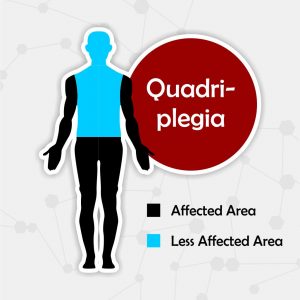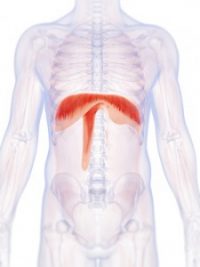
If you or someone you love is a person with quadriplegia, you are used to being asked a barrage of questions. What does it mean to be quadriplegic? What causes quadriplegia? How does quadriplegia affect your body? Is there a treatment for quadriplegia?
What is Quadriplegia?
Quadriplegia, also known as tetraplegia, is the paralysis of the body from at least the shoulders down. The paralysis is a result of damage to the spinal cord which prevents messages from the brain from being sent to the rest of the body. The spinal cord is not the bones of your spine. The spinal cord consists of the nerves that are protected and housed by the vertebrae of the spine. The location of the spinal cord damage determines the severity of the paralysis.
QUADRIPLEGIA AND BREATHING ASSISTANCE
High spinal cord injuries are often associated with breathing difficulties. For more information on breathing difficulties associated with spinal cord injuries, please click here: Spinal Cord Injury
Common Causes of Quadriplegia
The two main ways someone would become quadriplegic is by trauma resulting in a spinal cord injury or as a result of a medical issue/disease. The World Health Organization reports that up to 90% of spinal cord injury cases are due to trauma.
Spinal-Cord Injuries That Can Cause Quadriplegia
- Car accidents – The most common source of a spinal cord injury is a vehicular accident. Car accidents can injure not just the driver, but people of any age.
- Falls – Next to car accidents, falls are the second most common cause of quadriplegia due to spinal cord injuries. Dalen was 52 when he fell from a ladder and became quadriplegic.
- Violence – Stabbings and gunshot wounds along with other forms of violence cause almost as many cases of quadriplegia as falls do. Most people with quadriplegia caused by violence are young men.
- Sports Injuries – Diving accidents account for 66% of sports related spinal cord injuries resulting in paralysis. However, there are other sports that are risky to the spine. Brodie experienced a spinal cord injury in college because of a trampoline accident.
- Result of surgery/medical procedure – Far less frequently, quadriplegia is caused by a botched spinal surgery.
Medical Issues/Diseases that can cause Quadriplegia
Quadriplegia can also be caused by medical issues and diseases that affect the nerves of the spinal cord.
- Diseases of the brain stem can result to abnormalities in the function of cranial nerves which may lead to a host of medical issues, including quadriplegia. This can also include spinal meningitis which infects the brain stem and spinal cord and can cause quadriplegia.
- A stroke in the brain stem can interfere with vital functions such as breathing and heartbeat, and may also result in quadriplegia. When blood flow is interrupted, such as with a stroke, brain signals are disrupted, including signals being sent to arms or legs, resulting in paralysis
How Quadriplegia Affects the Body
There are many physical effects of quadriplegia including:
- Inability to move limbs below site of injury. Sometimes this includes the neck as well depending on the location of the spinal cord damage or degeneration.
- Changes in skin sensitivity. Some people with quadriplegia are able to feel sensations on their skin. The sensations might be felt constantly or intermittently. Some can feel pain. This can be frustrating when you aren’t able to move your limbs in order to relieve the pain.
- Bladder and bowel control. Because of the disruption in communication between the brain and the other organs of the body, a person with quadriplegia will learn a new way to empty the bladder and bowels.
- Changes in sexual function. This ranges from person to person. Some people are not able to function sexually while others adjust to changes in lubrication, erectile function, orgasm or fertility.
- Infections and sores. The decrease in mobility can lead to bed sores. If a person has a tracheostomy and device with wires and electrodes implanted under the skin there is constant risk of infection.
- Weight gain. Moving the body burns calories, but if there is no way to move the body there are less options for calorie burning. If a quadriplegic becomes overweight or obese, their health is further compromised.
- Emotional stress. Depression, anxiety, anger, feelings of hopelessness and helplessness weigh on the person with quadriplegia.
- Relational stress. Family relationships and friendship dynamics are changed forever. There is stress and strain when family members become caregivers.
- Difficulty breathing. This is the most concerning aspect of quadriplegia. The brain cannot communicate with the diaphragm properly to get a full breath. In other cases, the chest muscles are weakened so that the body is not strong enough to get a full breath on its own.
Treatment for Quadriplegia
There is no cure for quadriplegia, but there are ways to address the effects of quadriplegia. Wheelchairs can help with mobility. At home caregivers can ease the burden of the family caregiver. Physical therapy can help with pain and muscle function. Counseling can help with the emotional issues.
All of these improve the quality of life for the person with quadriplegia. However, the most important way to help is to give them breath.
Breath is life. Breath brings in life-giving oxygen. Breath rids the body of carbon-dioxide. Breathing deeply relieves stress, gives energy, and aids in proper sleep functioning.
Often times a person with quadriplegia is offered a ventilator in order to assist with breathing. However, there are many drawbacks to being on vent. The caring people at Avery Biomedical Devices knew there had to be a better way.
Where Avery Comes in…
For over 45 years, Avery Biomedical Devices has been giving their diaphragm pacing system to people with quadriplegia. Here is why their system is preferred over a ventilator and over other pacing systems:
- There is a lower risk of respiratory infections including pneumonia. A ventilator is not effective at preventing build up in the lungs.
- People don’t have to know that you need assistance with breathing. The Avery Diaphragm Pacemaker works silently so that no one has to know it’s there. It’s small enough that no one will point it out.
- You can hear what is going on around you. It operates silently so that you can even participate in a classroom or educational setting without disrupting those around you with the noise of a ventilator.
- No tracheostomy is needed. That means no risk of infection and improved eating, drinking, and smelling.
- The Avery pacing system mimics natural breathing patterns unlike a ventilator. The diaphragm pacing system draws air into the lungs. In contrast, a mechanical positive pressure ventilation system forces air into the chest under positive pressure which is not as comfortable for the body.
- There is less risk for skin infection. Other pacing devices on the market include wired electrodes implanted through the skin leaving a wound at risk of constant infection. Avery’s diaphragm pacemaker works through radio frequency receivers without leaving the skin vulnerable to infection.
- Don’t need to lug around a lot of equipment. Portable ventilators are big and bulky. The small size of the pacemaker makes it easy to transport. That means the quadriplegic can more easily be on the go!
- It has premarket approval for both adult and pediatric quadriplegics. The Avery Diaphragm pacemaker is approved for kids. Many kids around the world love their life with the device! https://averybiomedical.com/success-stories/pediatric-quadriplegia/
- It’s much cheaper to operate than a mechanical ventilator. It pays for itself in two years. It is reimbursable under Medicare and is covered for reimbursement under most private insurance plans around the world.
Give comfort, mobility, and quality of life to the quadriplegic in your life with the Avery Diaphragm Pacemaker. Contact Avery Biomedical Devices to find out how you can give breath to the quadriplegic in your life.
Content reviewed July, 2024 by Dr. Don Headley, M.D.
Dr. Headley is an otolaryngologist (ENT) with almost 40 years of experience in medicine. He is a graduate of George Washington University School of Medicine and Health Science, has been affiliated with St. Joseph’s Hospital and Medical Center in Phoenix, Arizona, and previously served as assistant professor of Internal Medicine and Surgery and Creighton University Medical School in Omaha, NE.

